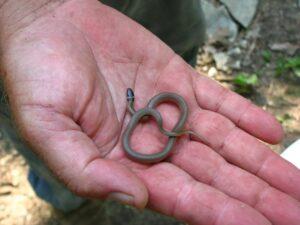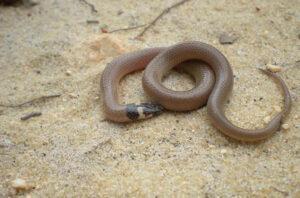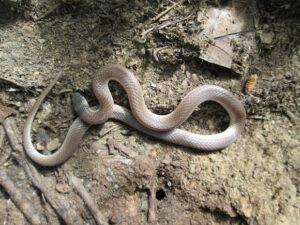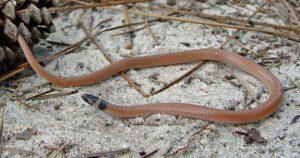The southeastern crowned snake is a small, slender colubrid snake native to the southeastern United States. It is an expert burrower in sandy soil. Being secretive, it can be rarely seen, even in areas it commonly inhabits. It can be identified by a light band at the back of its head. The specific name coronata is derived from the Latin word corona, meaning ‘crown’, while the genus name Tantilla is derived from the Latin word tantillus, meaning ‘so little’.
Scientific Classifications
- Suborder:Serpentes
- Family:Colubridae
- Genus:Tantilla
- Species:T. coronata
Conservation Status
Description
Size
The adults of this species grow to a length of 8-10 inches (20-25 cm).
Color and Appearance
This snake is solid light brown or grayish-brown in color. Its head is pointed and black with a cream or yellowish band between the head and the neck. A 3-5-scale wide black collar follows it. The remaining back of the body is reddish brown, while the belly is solid white or light pink. The smooth dorsal scales are arranged in 15 rows, and the anal plate is divided.
Are They Dangerous to Humans
Though rear-fanged, the small southeastern crowned snake is considered non-venomous to humans. It tries to burrow in sand or crawl beneath organic litter and other debris when threatened. The skilled burrower appears to ‘swim’ in the sand when it attempts to escape from being captured. It doesn’t bite when captured but releases a foul-smelling musk from its scent glands.
Southeastern Crowned Snakes at a Glance
Distribution
It is found in northwestern Florida, Alabama, extreme southern Indiana, Georgia, western Kentucky, Mississippi, eastern Louisiana, North Carolina, South Carolina, south-central Virginia, and Tennessee.
Habitat
The snake is commonly found in damp and dry woodlands. Its largest populations live in areas with loose or sandy soils and abundant organic litter.
It is active during the day in the warm summer months, when it can be found underneath logs, rocks, and organic litter. Though it hibernates in the coldest winter months, it is active in its habitat on the warmer winter days. During the early evening hours, it crosses overland.
Destruction or damage of its forest habitats can pose a threat to its future population.
Lifespan
The Florida brown snake can live up to 7 years.
Predators
Many carnivorous vertebrates living in forests prey on the southeastern crowned snake. Its most common predators are the coral snake and kingsnake.
Diet
It eats different types of small prey like termites, centipedes, worms, spiders, and earth-dwelling insect larvae. It uses its small, chiseled fangs located at the back of its jaw to inject venom to subdue its prey.

Reproduction
Oviparous (lays eggs that hatch outside the body)
Generally, 1-3 eggs are laid in a clutch. Mating occurs in spring through fall. Females mating in fall store the sperms in their bodies till the following spring. Eggs are laid in June and July, and they hatch in fall. The juveniles resemble the adults in their looks.
Similar Species
Red-bellied Snake
The red-bellied snake, Storeria occipitomaculata, has a reddish underside and 3 light spots across the neck.
Florida Crowned Snake
In the Florida crowned snake, Tantilla relicta, the light neck band is usually absent or less prominent, and it has a different geographic range.
The ring-necked snake, Diadophis punctatus, is uniformly gray to almost black with a distinctive red, yellow, or yellow-orange band on its neck. It lacks the black collar on its neck.
Source
ferrebeekeeper.files.wordpress.com, projectnoah.org, i.pinimg.com, alabamaherps.com








